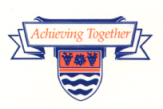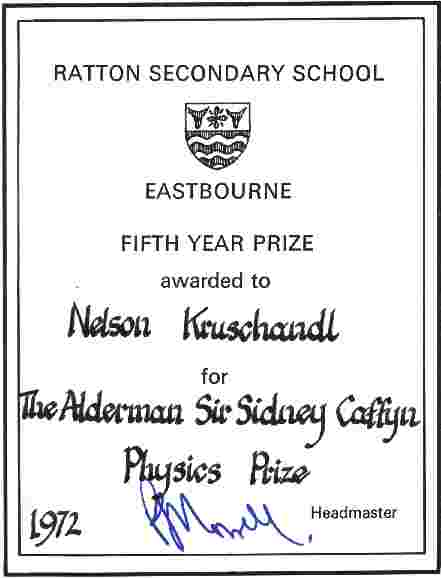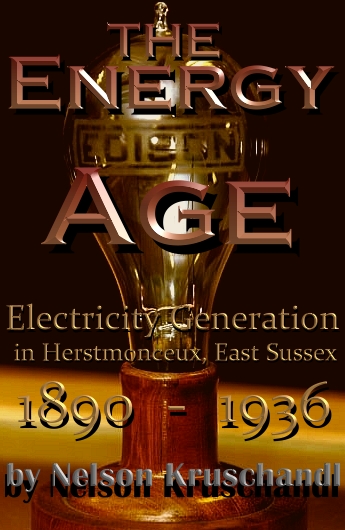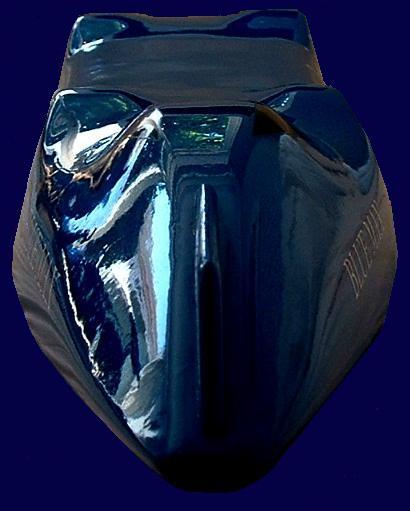|

RATTON’S
MOTTO
“Achieving
Together”
The
designer
of Solar
Navigator attended Ratton school between 1968 to
1972, after which he enrolled at the Eastbourne College
of Further Education to study engineering. His favorite subjects were
physics and
technical drawing. He did not enjoy maths or
history - how times change. Nelson received no
encouragement from staff for his ideas, but some
teachers noticed a spark when it came to science.

Nelson
Kruschandl - former student
With
the internet, you may realize that your interests are
not that strange - in fact, you'll see that they are
quite popular. Nelson says: "learn
as much as you can while at school. Teachers are
your friends. If you want help - ask for it.
To many of you it may seem like a waste of time
right now, but you do need this basic grounding to prepare
you for a fuller life."

Prize
Certificate 1972
Perhaps
the first recognition of his interest in the sciences. Nelson
Kruschandl reveals seeing the above Prize Certificate brings back fond
memories of Ratton Secondary School near Eastbourne in East Sussex.
Especially of his Physics master, Mr Henderson, English master Mr Mansell,
Math tutor Mr Campbell and his early draughting lessons with Mr Rippengal.
Mr
Campbell and Mr Mansell would no doubt have been pleased to learn that
Nelson has written a book about his archaeological exploits at Herstmonceux,
now with the scientific backing of English
Heritage, Archaeology South
East and the County Archaeologist. The building the subject of this book
is on a Monument Protection Programme (the process of discovery for which
is included). This is an informative educational trip back in time with
eye witness testimony from two local residents who lived in Herstmonceux
at the time.
But
Nelson.s bungling local authority and the Secretary of State got it wrong
many years ago and still won't admit to their mistake. Or was it a
mistake? Nelson's next book in the series reveals the inner workings of Wealden
District Council with the benefit of transcribed recordings of council
meetings and extracts from the Secretary of State's planning decision
letters.

Without
mentors to mould and guide us in our formative years, we could not
flourish. Nelson says: "I wish I'd been more attentive at
school and confided my ambitions."
"To all my
class mates who've stopped me in the street and wished me well in my
endeavors - thanks. It really helps to have your support, and now
you'll know the truth about all the stories you've read about me in the
papers; to be revealed in this series of books, which I hope you will find
both interesting and amusing. Thank heavens for my sense of humour."
Whatever
his teachers thought of him, their efforts resulted in some quite
extraordinary projects. The certificate is signed by the Headmaster, Peter
Morrell with thanks to all his teachers, classmates and Sir Sidney Caffyn
for the encouragement they gave Nelson. It was surely that encouragement
that eventually led to Nelson attaining two patents (Joystick
and EV refueling)
the Blueplanet Ecostar project and the SolarNavigator concept. From little acorns
frames of steel and ally grow. For 2013, a fresh patent
is being developed. Which proves that age is not necessarily a barrier
to progress.
BLUEPLANET
ECOSTAR 
Solar
charged battery electric WORLD
Land Speed Record CAR
-
Number:
29/G/ENT/CIP/12/C/N05S00 - Promotion of electric vehicle
technologies. We missed the European Commission call last year (2012).
This project is suitable for collaborative research at University level.
Should another call be for the promotion of EV technology, the designer
will donate the materials, motors and free consultancy, provided that a
group of students have the support and guidance of their faculty and
proper supervision.
-
-
This
vehicle has built in battery cartridge exchange, that allows refuelling
betweens record runs in less than two minutes. The system has been
ratified by the FIA. The logical development is to go on to develop a
station forecourt for any EV so equipped - a design for which is available
- to be developed. perhaps for a Degree or Masters Degree student, or
students.

Project:
Blueplanet Ecostar
An
electric land speed record car that refuels itself by changing battery packs
between each run - charged by solar power.
Email:
 or phone UK:
or phone UK:
+
44 (0) 1323 831727
+44
(0) 7842 607865
OTHER
EASTBOURNE SCHOOLS
Ratton
after school club 3:15 to 6:00 pm
Telephone:
01323 - 504011
E-Mail:
t.comfort@ratton.e-sussex.sch.uk
PHYSICS
Physics (from Ancient Greek: φύσις physis "nature") is a part of natural philosophy and a natural science that involves the study of matter and its motion through
space and time, along with related concepts such as energy and force. More broadly, it is the general analysis of nature, conducted in order to understand how the universe behaves.
Physics is one of the oldest academic disciplines, perhaps the oldest through its inclusion of astronomy. Over the last two millennia, physics was a part of natural philosophy along with chemistry, certain branches of mathematics, and biology, but during the Scientific Revolution in the 17th century, the natural sciences emerged as unique research programs in their own right. Physics intersects with many interdisciplinary areas of research, such as biophysics and quantum chemistry, and the boundaries of physics are not rigidly defined. New ideas in physics often explain the fundamental mechanisms of other sciences, while opening new avenues of research in areas such as mathematics and philosophy.
Physics also makes significant contributions through advances in new technologies that arise from theoretical breakthroughs. For example, advances in the understanding of electromagnetism or nuclear physics led directly to the development of new products which have dramatically transformed modern-day society, such as television, computers, domestic appliances, and nuclear weapons; advances in thermodynamics led to the development of industrialization; and advances in mechanics inspired the development of calculus.
PHILOSOPHY
In many ways, physics stems from ancient Greek philosophy. From Thales' first attempt to characterize matter, to Democritus' deduction that matter ought to reduce to an invariant state, the Ptolemaic astronomy of a crystalline firmament, and Aristotle's book Physics (an early book on physics, which attempted to analyze and define motion from a philosophical point of view), various Greek philosophers advanced their own theories of nature. Physics was known as natural philosophy until the late 18th century.
By the 19th century physics was realized as a discipline distinct from philosophy and the other sciences. Physics, as with the rest of science, relies on philosophy of science to give an adequate description of the scientific method. The scientific method employs a priori reasoning as well as a posteriori reasoning and the use of Bayesian inference to measure the validity of a given theory.
The development of physics has answered many questions of early philosophers, but has also raised new questions. Study of the philosophical issues surrounding physics, the philosophy of physics, involves issues such as the nature of space and time, determinism, and metaphysical outlooks such as empiricism, naturalism and realism.
Many physicists have written about the philosophical implications of their work, for instance Laplace, who championed causal determinism, and Erwin Schrödinger, who wrote on quantum mechanics. The mathematical physicist Roger Penrose has been called a Platonist by Stephen Hawking, a view Penrose discusses in his book, The Road to Reality. Hawking refers to himself as an "unashamed reductionist" and takes issue with Penrose's views.
CORE THEORIES
Though physics deals with a wide variety of systems, certain theories are used by all physicists. Each of these theories were experimentally tested numerous times and found correct as an approximation of nature (within a certain domain of validity). For instance, the theory of classical mechanics accurately describes the motion of objects, provided they are much larger than atoms and moving at much less than the speed of light. These theories continue to be areas of active research, and a remarkable aspect of classical mechanics known as chaos was discovered in the 20th century, three centuries after the original formulation of classical mechanics by Isaac Newton (1642–1727).
These central theories are important tools for research into more specialized topics, and any physicist, regardless of his or her specialization, is expected to be literate in them. These include classical mechanics, quantum mechanics, thermodynamics and statistical mechanics, electromagnetism, and special relativity.
CLASSICAL PHYSICS
Classical physics includes the traditional branches and topics that were recognized and well-developed before the beginning of the 20th century—classical mechanics, acoustics, optics, thermodynamics, and electromagnetism. Classical mechanics is concerned with bodies acted on by forces and bodies in motion and may be divided into statics (study of the forces on a body or bodies at rest), kinematics (study of motion without regard to its causes), and dynamics (study of motion and the forces that affect it); mechanics may also be divided into solid mechanics and fluid mechanics (known together as continuum mechanics), the latter including such branches as hydrostatics, hydrodynamics, aerodynamics, and pneumatics. Acoustics, the study of sound, is often considered a branch of mechanics because sound is due to the motions of the particles of air or other medium through which sound waves can travel and thus can be explained in terms of the laws of mechanics. Among the important modern branches of acoustics is ultrasonics, the study of sound waves of very high frequency beyond the range of human hearing. Optics, the study of light, is concerned not only with visible light but also with infrared and ultraviolet radiation, which exhibit all of the phenomena of visible light except visibility, e.g., reflection, refraction, interference, diffraction, dispersion, and polarization of light. Heat is a form of energy, the internal energy possessed by the particles of which a substance is composed; thermodynamics deals with the relationships between heat and other forms of energy. Electricity and magnetism have been studied as a single branch of physics since the intimate connection between them was discovered in the early 19th century; an electric current gives rise to a magnetic field and a changing magnetic field induces an electric current. Electrostatics deals with electric charges at rest, electrodynamics with moving charges, and magnetostatics with magnetic poles at rest.
MODERN PHYSICS
Classical physics is generally concerned with matter and energy on the normal scale of observation, while much of modern physics is concerned with the behavior of matter and energy under extreme conditions or on the very large or very small scale. For example, atomic and nuclear physics studies matter on the smallest scale at which chemical elements can be identified. The physics of elementary particles is on an even smaller scale, as it is concerned with the most basic units of matter; this branch of physics is also known as high-energy physics because of the extremely high energies necessary to produce many types of particles in large particle accelerators. On this scale, ordinary, commonsense notions of space, time, matter, and energy are no longer valid.
The two chief theories of modern physics present a different picture of the concepts of space, time, and matter from that presented by classical physics. Quantum theory is concerned with the discrete, rather than continuous, nature of many phenomena at the atomic and subatomic level, and with the complementary aspects of particles and waves in the description of such phenomena. The theory of relativity is concerned with the description of phenomena that take place in a frame of reference that is in motion with respect to an observer; the special theory of relativity is concerned with relative uniform motion in a straight line and the general theory of relativity with accelerated motion and its connection with gravitation. Both quantum theory and the theory of relativity find applications in all areas of modern physics.
APPLIED PHYSICS
Applied physics is a general term for physics research which is intended for a particular use. An applied physics curriculum usually contains a few classes in an applied discipline, like geology or electrical engineering. It usually differs from engineering in that an applied physicist may not be designing something in particular, but rather is using physics or conducting physics research with the aim of developing new technologies or solving a problem.
The approach is similar to that of applied mathematics. Applied physicists can also be interested in the use of physics for scientific research. For instance, people working on accelerator physics might seek to build better particle detectors for research in theoretical physics.
Physics is used heavily in engineering. For example, statics, a subfield of mechanics, is used in the building of bridges and other structures. The understanding and use of acoustics results in better concert halls; similarly, the use of optics creates better optical devices. An understanding of physics makes for more realistic flight simulators, video games, and movies, and is often critical in forensic investigations.
With the standard consensus that the laws of physics are universal and do not change with time, physics can be used to study things that would ordinarily be mired in uncertainty. For example, in the study of the origin of the earth, one can reasonably model earth's mass, temperature, and rate of rotation, over time. It also allows for simulations in engineering which drastically speed up the development of a new technology.
But there is also considerable interdisciplinarity in the physicist's methods and so many other important fields are influenced by physics, e.g. the fields of econophysics and sociophysics.
RESEARCH, SCIENTIFIC
METHOD & EXPERIMENTS
Physicists use the scientific method to test the validity of a physical theory, using a methodical approach to compare the implications of the theory in question with the associated conclusions drawn from experiments and observations conducted to test it. Experiments and observations are collected and compared with the predictions and hypotheses made by a theory, thus aiding in the determination or the validity/invalidity of the theory.
A scientific law is a concise verbal or mathematical statement of a relation that expresses a fundamental principle of a theory, like Newton's law of universal gravitation.
Theorists seek to develop mathematical models that both agree with existing experiments and successfully predict future results, while experimentalists devise and perform experiments to test theoretical predictions and explore new phenomena. Although theory and experiment are developed separately, they are strongly dependent upon each other. Progress in physics frequently comes about when experimentalists make a discovery that existing theories cannot explain, or when new theories generate experimentally testable predictions, which inspire new experiments.
Physicists who work at the interplay of theory and experiment are called phenomenologists. Phenomenologists look at the complex phenomena observed in experiment and work to relate them to fundamental theory.
Theoretical physics has historically taken inspiration from philosophy; electromagnetism was unified this way. Beyond the known universe, the field of theoretical physics also deals with hypothetical issues, such as parallel universes, a multiverse, and higher dimensions. Theorists invoke these ideas in hopes of solving particular problems with existing theories. They then explore the consequences of these ideas and work toward making testable predictions.
Experimental physics informs, and is informed by, engineering and technology. Experimental physicists involved in basic research design and perform experiments with equipment such as particle accelerators and lasers, whereas those involved in applied research often work in industry, developing technologies such as magnetic resonance imaging (MRI) and transistors. Feynman has noted that experimentalists may seek areas which are not well-explored by theorists.
|



